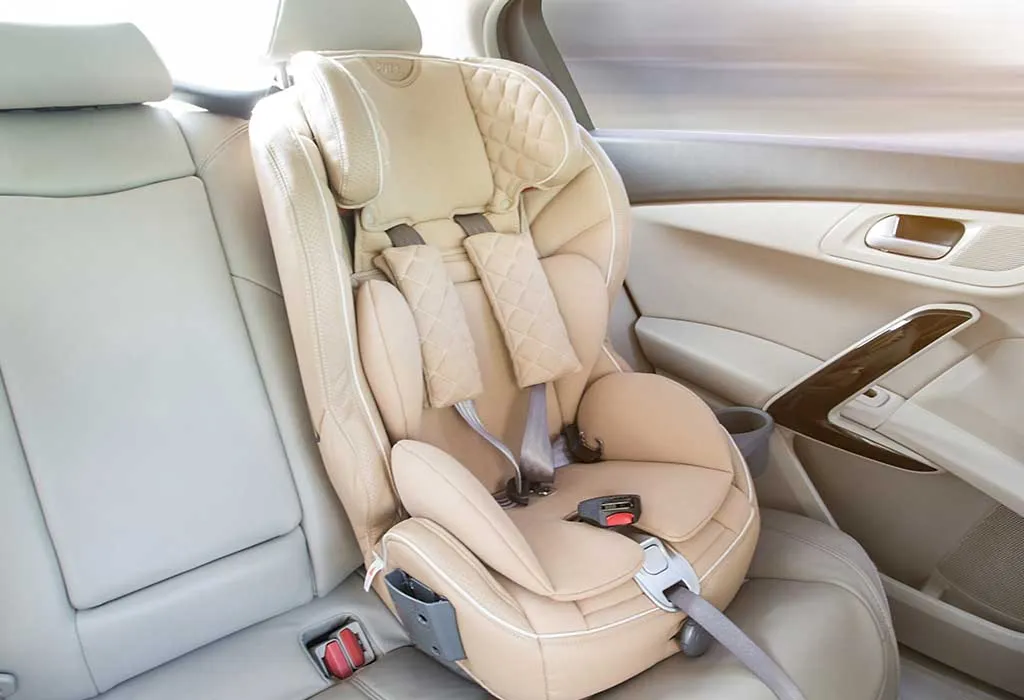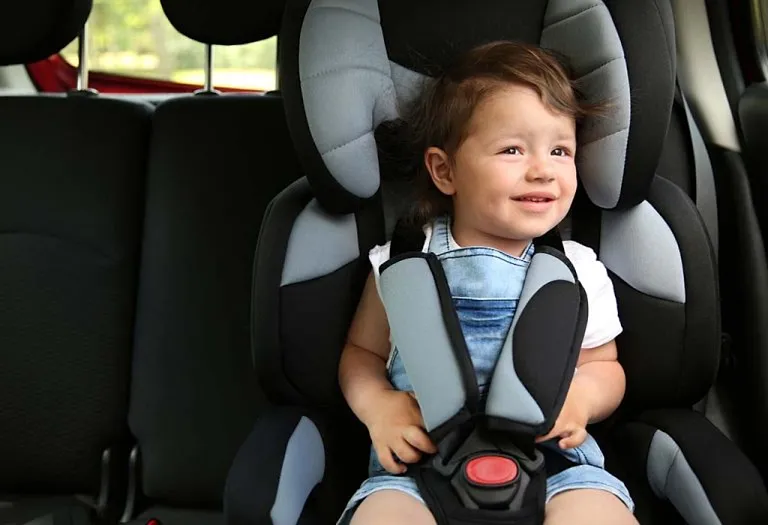Car Seat Expiration – When and Why Do They Expire
- Why Do Car Seats Expire, and Do They Have Expiration Dates?
- Is It Safe to Use Expired Car Seats?
- How Long Do They Last?
- Where to Find Expiration Dates on Car Seats?
- How Frequently Should You Replace a Car Seat?
- Do Car Seat Bases and Booster Seats Expire?
- What to Do With Expired Car Seats?
- How to Properly Dispose of an Expired Car Seat?
- FAQs
Child car seats are one of the most important child gear you’ll buy, and just like other gear, these car seats can get really expensive. Even when you buy the top-of-the-line car seat for your baby, your child will not use the seat forever. Thus, you might want to use your old car seat for your newborn, lend it to someone else quickly, or consider donating it to someone in need. But while doing so, be aware that child car seats do expire. Most child car seat manufacturers claim that the useful life of a car seat is about 6 to 10 years from the date of manufacture, depending on the seat model. Read on to learn all about car seat expiration.
Why Do Car Seats Expire, and Do They Have Expiration Dates?
Do infant car seats expire? A simple answer to this question is yes, child car seats do have an expiry date, and they do expire for more than one reason. Sometimes your car seat may become useless even before the mentioned expiry date. Let’s understand how long do car seats last, why these child car seats expire, and why they have an expiration date (1).
Reasons why car seats expire:
1. Regular Wear & Tear
The most common and hazardous cause of child car seat expiry is the wearing and tearing of the car seat due to regular usage. Some people argue that their child’s car seat is used only so many times, and it’s only a marketing scheme to fool people into buying new car seats. But agreeing to that statement could be a serious mistake. Car seats are made with plastic, steel, and webbing materials, during a car ride these materials are exposed to a lot of pressure and stress. Additionally, these materials also face the changing temperature of your car and tolerate many spilled liquids and mishandlings. It might not be very visible to the naked eye, but all this leads to the degradation of material over time and affects the strength of the material and overall seat. And no parent would ever want a weak car seat for their children.
2. Changes In Quality Standards & Safety Regulations
Your baby’s safety and security is the number one priority for any child car seat manufacturer. And to meet this promise, manufacturers keep their products comply with the latest safety standard published by the federal government, state and transportation agencies, crash test benchmarks, and car manufacturers. Some manufactures test their child car seat product line beyond the industry standard to ensure that your baby is always in the safest seat. This change in the weight and height limitations of the harness or any other criteria can make your current car seat outdated.
3. New & Improved Car Seat
There are multiple car seat manufacturers in the market, and all of them spend big money on their R&D to render out the best product for their customers. Like any other product, child car seats are also updated and renewed in terms of their design and functionality. Often, these improved versions of car seats are loaded with useful technology and design aesthetics. This makes the older models obsolete in usability, as parents look for ease of use in the product they acquire for their offsprings.
4. Manufacturing Recalls
This might seem like an odd reason for a child’s car seat to expire, but it’s not. Many manufacturers run a recall program for their older models which might need some repair or are reported to have some trouble with the safety of the product. If you registered your newly purchased car seat, then you get a call from the company asking to return the product in exchange for a repair or maintenance or a self-care repair kit. If the product is too obsolete to repair, the manufacturer may ask you to dispose of the seat in a prescribed manner.
Is It Safe to Use Expired Car Seats?
Using expired car seats is not safe because the materials degrade over time, compromising their ability to protect your child in a crash; expiration dates (typically 6-10 years from manufacture) are set by manufacturers based on wear-and-tear testing, and older seats may have weakened plastic, frayed straps, or outdated safety standards, making them unreliable in an accident. Always check the expiration label (usually on the seat’s base or back) and replace expired seats to ensure maximum safety.
How Long Do They Last?
Car seats typically last between 6 to 10 years from the date of manufacture, depending on the brand and model, as plastics and other materials degrade over time due to heat, UV exposure, and general wear. Manufacturers set expiration dates based on safety testing, and using a seat beyond this period can compromise its structural integrity in a crash. Some seats expire sooner if involved in a crash, or if parts are damaged or missing.
Where to Find Expiration Dates on Car Seats?
Most child car seat manufacturers display the exact date of expiry at the bottom, back of the seat, or stamped into the plastic car seat frame, making it easy to find the car seat expiration date. While some manufacturers only provide the date of manufacturing (DOM), this date can be found under or at the bottom of the seat. And since most of these car seats expire in 6 years, one can easily calculate the date of expiry by the given DOM. However, the best way to find out the correct date of expiry is to read the instruction manual or visit the company’s website. If you bought parts individually (like a car seat base separate from the seat), make sure to check the expiration date on each piece, since they might not expire at the same time. Some high-end car seat has a shelf life of 8 to 10 years; in that case, it is wise not to be hasty in retiring the seat before checking its expiry date from the makers.
How Frequently Should You Replace a Car Seat?
You should replace a car seat every 6 to 10 years, depending on the manufacturer’s expiration date, since materials like plastic and straps weaken over time. Additionally, replace it immediately after a moderate or severe crash, if it’s recalled, or if it shows cracks, fraying, or missing parts. However, expiration isn’t the only factor – seats must also be replaced when a child outgrows the height or weight limits and reaches the recommended age for the next seat stage (like transitioning from an infant seat to a convertible seat).
Do Car Seat Bases and Booster Seats Expire?
Car seat bases and booster seats don’t last forever—they have expiration dates just like car seats. Over time, sun exposure, temperature changes, and general wear can weaken the materials, making them less reliable in a crash. Most expire 6 to 10 years after manufacture, but always double-check the label (often hidden on the bottom or back). And if they’ve been in a crash or look worn out, don’t wait—swap them out early to keep your little one safe (2).
What to Do With Expired Car Seats?

Now that you are aware that your car seat has expired, you might just put it aside in your garage or the attic or throw it away on the street for the sanitation worker to collect. The first thing to do is to make sure that you mark that expired car seat in visible font as ‘expired’ or ‘unsafe’. Also, don’t donate that car seat to anyone; if it’s dangerous for your baby, it’s dangerous for anyone else’s too. Here’s what you can do with an expired car seat (3):
1. Trade-in Programs
Some retailers and wholesalers in association with car seat makers run a trade-in program where you can exchange the old and expired child car seats for shopping coupons, discounts on new seats, and gift vouchers. Trade-in programs are your best bet for that seat, and since you are not the only parent with an expired seat coated with dust, keeping your eyes open to the advertisement is your only chance to get a hand on those coupons.
2. Recycle
Exchange and trade-in programs get to reach their quotas in a short span of time as they get a huge response from parents. The only other viable option is to recycle your car seat; if your respective state and local departments of public work accept recycling of car seat plastic, then it is advised to recycle your expired car seat and follow the proper recycling procedure (4).
3. Disposal
Lastly, all you can do to get rid of that car seat is to dispose of it in the trash. Even when disposing of the car seat, you should follow the standard method. Remove all metal, fabric, foam, and padding from the seat before you throw it in the trash.
How to Properly Dispose of an Expired Car Seat?
Disposing car seats require some consideration. You can’t just leave an unsafe car seat on your trash on the road. To properly dispose of an expired car seat you need to follow simple steps: remove all extra padding and cushion from the seat; cut all the harness and straps; remove any other hard object or metal; lastly mark it unsafe so no one will use it after you leave it out.
FAQs
1. Does storing a car seat prolong its expiration date?
Even if unused, a car seat still expires based on its manufacture date—not usage. Heat, humidity, and plastic degradation occur over time, even in storage.
2. Do secondhand car seats expire sooner than new ones?
Yes—if the seat was exposed to sunlight, extreme temps, or improper cleaning, its materials may degrade faster. Always verify its full history and date of expiry for the car seat.
3. Why do some car seats expire in 6 years while others last 10?
Materials and testing vary by brand. Infant seats (used more frequently) often expire sooner, while boosters may last longer. Always check the label.
We hope we have answered your question – how long are car seats good for. A child’s car seat is a necessity, and a parent cannot ignore making this essential purchase. If you’re looking to buy a car seat after proper planning, it becomes evident that you know what you are buying and how long it’s going to last. Many parents, mostly first-timers, are unaware and can be found on the internet asking questions like ‘how many years are car seats good for’ or ‘I want to know if my car seat has expired’ or something else. To answer their queries, car seat bases expire, and they do need to be replaced or disposed of in a correct manner. If you have an expired car seat, the first thing you’d want to do is never to use it again. Secondly, you need to know how to treat the unusable car seat. And lastly, the most important thing to understand is that even if your expired car seat is in mint condition and shows no sign of any wear and tear, you still shouldn’t be using that car seat. There is a reason why there’s an expiry date on the product, and following it is the right parenting move.
References/Resources:
1. Cincinnati Children – Car Seat Expiration Dates – Have You Checked Yours?
2. NHTSA – Car Seat Use After a Crash
3. Safe Kids Worldwide – What to do with your old car seat
4. Vanderbilt University Medical Center – Pediatric Trauma Injury Prevention Program
Also Read:
Types of Infant Car Seats and Other Restraints
The Perfect Car Seat & Restraints for Your Toddler
Know the Right Age for Your Baby to Face Forward in a Car Seat
Was This Article Helpful?
Parenting is a huge responsibility, for you as a caregiver, but also for us as a parenting content platform. We understand that and take our responsibility of creating credible content seriously. FirstCry Parenting articles are written and published only after extensive research using factually sound references to deliver quality content that is accurate, validated by experts, and completely reliable. To understand how we go about creating content that is credible, read our editorial policy here.























